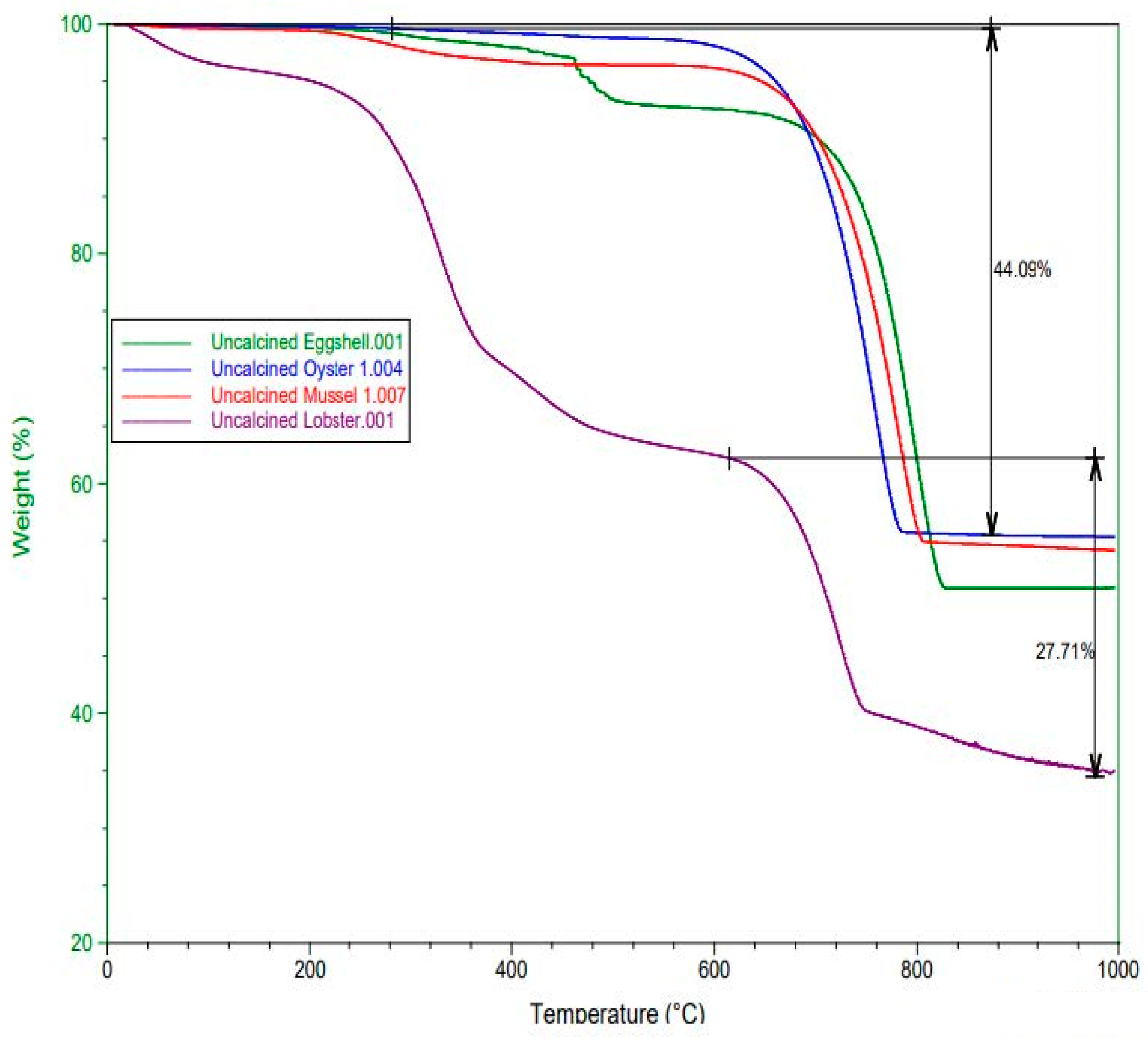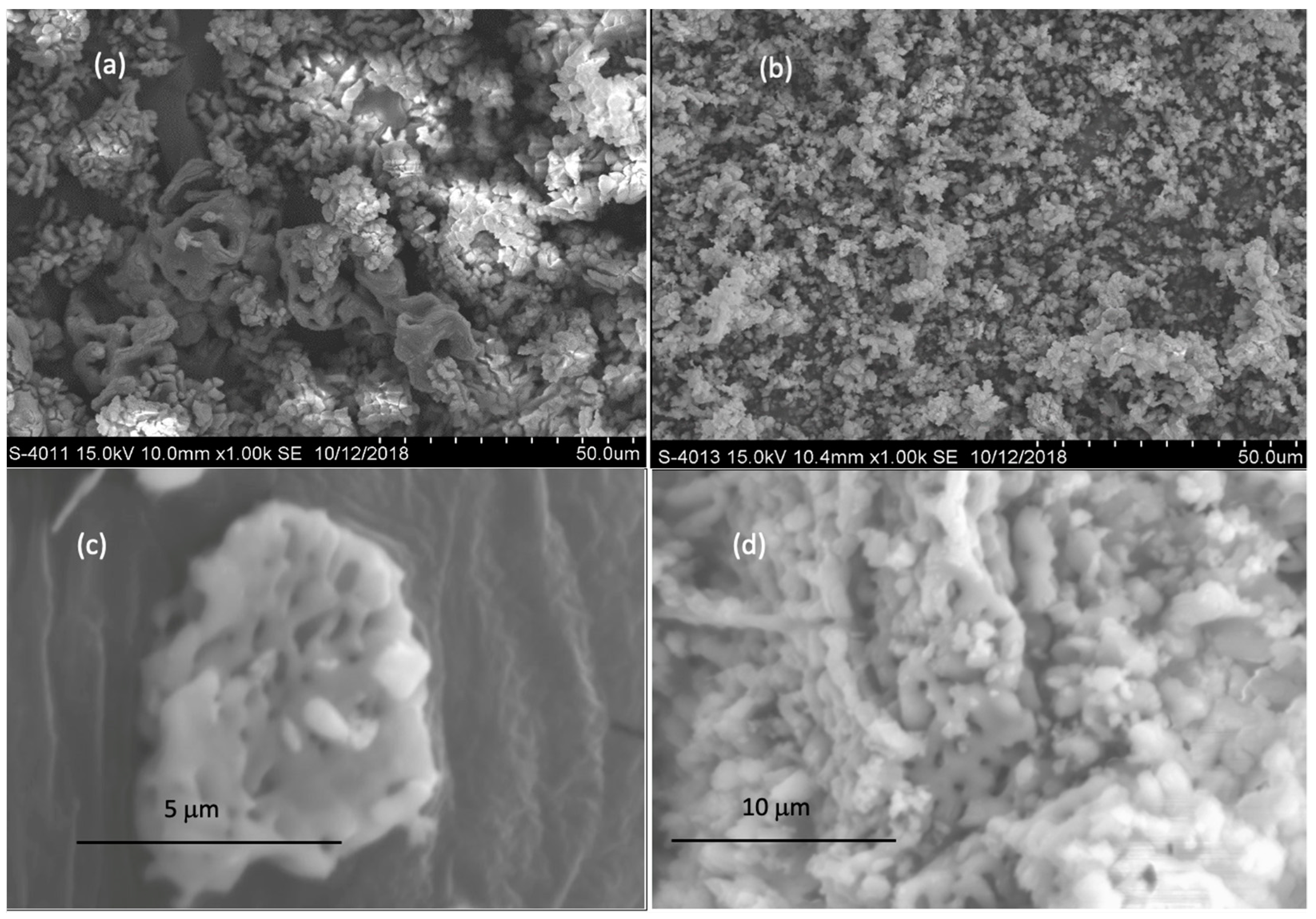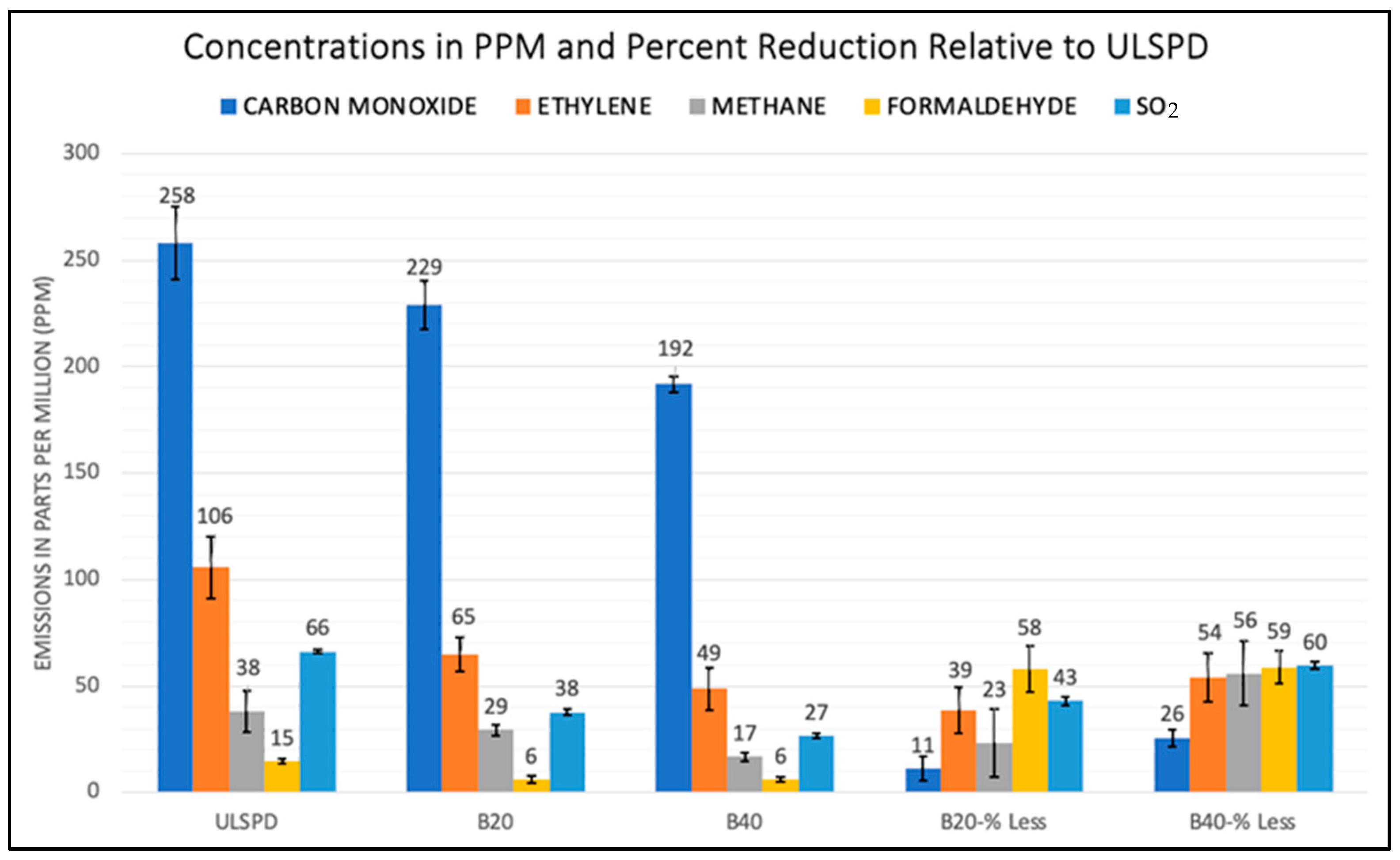Preparation and Characterization of Shell-Based CaO Catalysts for Ultrasonication-Assisted Production of Biodiesel to Reduce Toxicants in Diesel Generator Emissions
Abstract
:1. Introduction
Transesterification
2. Materials and Methods
2.1. Materials and Reagents
2.2. Preliminary Preparation of Shells
2.2.1. Preparation of CaO Catalyst via Calcination
2.2.2. Preparation of CaO-ZnO Mixed Catalyst
2.3. Catalyst Characterization
2.4. Ultrasonication-Assisted Biodiesel Synthesis and Yield Measurement
2.5. GC-MS Analysis of Diesel Generator Emissions
3. Results
3.1. Catalyst Characterization
3.1.1. Thermogravimetric Analysis (TGA)
3.1.2. Characterization of Catalysts by SEM/EDX and XRF Methods
3.1.3. FTIR Analysis of CaO and CaO-ZnO Mixed Catalysts Derived from Shell Samples
3.1.4. X-ray Diffraction Patterns of the Shell-Derived CaO and CaO-ZnO Mixed Catalysts
- Lobster CaO: → 32.1°, 37.0°, 53.5°, 63.8° and 67.0°
- Eggshell CaO: → 32.3°, 37.5°, 54.0°, 64.5° and 67.5°
- Mussel CaO: → 32.8°, 38.0°, 54.5°, 64.8° and 68.1°
- Oyster CaO: → 32.8°, 38.0°, 54.5°, 64.8° and 68.1°
3.2. Comparison of Biodiesel Yields Using Different Calcined Catalysts
| Catalyst (Weight %) | Method | Time (min) | Yield (%) |
|---|---|---|---|
| Oyster CaO (1%) | Present ultrasonication study | 10 | 92.9 |
| Mussel CaO (1%) | Present ultrasonication study | 10 | 89.0 |
| Eggshell CaO (1%) | Present ultrasonication study | 10 | 90.3 |
| Lobster CaO (1%) | Present ultrasonication study | 10 | 50.6 |
| 5%Zn-Mussel-CaO (1%) | Present ultrasonication study | 10 | 92.8 |
| 5%Zn-Eggshell-CaO (1%) | Present ultrasonication study | 10 | 92.5 |
| 5%Zn-Lobster-CaO (1%) | Present ultrasonication study | 10 | 59.5 |
| 5%Zn-Oyster-CaO (1%) | Present ultrasonication study | 10 | 93.9 |
| 7%Zn-Oyster-CaO (1%) | Present ultrasonication study | 10 | 67.2 |
| 10%Zn-Oyster-CaO (1%) | Present ultrasonication study | 10 | 62.3 |
| CaO (3%) | Hotplate with stirring, 25:1 CH3OH-jatropha oil, [44] | 180 | 91 |
| CaO-ZnO (3%) | Hotplate with stirring, 25:1 CH3OH-jatropha oil, [44] | 180 | 94 |
| CaZn2(OH)6.2H2O (2%) | Hotplate with stirring, 10:1 CH3OH-sunflower oil, [45] | 120 | 92 |
| 1.5-Zn/CaO-550 (5%) | Hotplate with stirring, 9:1 CH3OH-cottonseed oil, 1.5 wt.% Zn-CaO calcined at 550 °C [27] | 45 | >99 |
| CaO-ZnO (10%) | Hotplate with stirring, 40:1 CH3OH-soybean oil, [46] | 360 | 73 |
| Eggshell CaO (6.04%) | Ultrasonication 299.7 W; 8.3:1 CH3OH-waste cooking oil, 55 °C [12] | 39.8 | 98.6 |
| Crab shell CaO (3%) | 250 rpm stirring rate; 9:1 CH3OH-fishmeal plant oil, 60 °C [21] | 60 | 88.2 |
| Snail shell CaO (3%) | Heating mantle, 65 °C; 6:1 CH3OH-waste palm cooking oil [20] | 180 | 80 |
3.3. Emissions of Biodiesel Fuel Blends in Diesel Generators
3.3.1. FTIR Analysis of Emissions from Diesel Power Generators
3.3.2. GC-MS Analysis of VOCs
4. Discussion
5. Conclusions
Supplementary Materials
Author Contributions
Funding
Data Availability Statement
Acknowledgments
Conflicts of Interest
References
- Wong, K.Y.; Ng, J.-H.; Chong, C.T.; Lam, S.S.; Chong, W.T. Biodiesel Process Intensification through Catalytic Enhancement and Emerging Reactor Designs: A Critical Review. Renew. Sustain. Energy Rev. 2019, 116, 109399. [Google Scholar] [CrossRef]
- Efavi, J.K.; Kanbogtah, D.; Apalangya, V.; Nyankson, E.; Tiburu, E.K.; Dodoo-Arhin, D.; Onwona-Agyeman, B.; Yaya, A. The Effect of NaOH Catalyst Concentration and Extraction Time on the Yield and Properties of Citrullus Vulgaris Seed Oil as a Potential Biodiesel Feed Stock. S. Afr. J. Chem. Eng. 2018, 25, 98–102. [Google Scholar] [CrossRef]
- Ling, J.; Tan, Y.; Mujawar, M.; Kansedo, J.; Saptoro, A.; Nolasco-Hipolito, C. A Review of Heterogeneous Calcium Oxide Based Catalyst from Waste for Biodiesel Synthesis. SN Appl. Sci. 2019, 1, 810. [Google Scholar] [CrossRef] [Green Version]
- Banerjee, N.; Barman, S.; Saha, G.; Jash, T. Optimization of Process Parameters of Biodiesel Production from Different Kinds of Feedstock. Mater. Today: Proc. 2018, 5, 23043–23050. [Google Scholar] [CrossRef]
- Yang, C.; He, K.; Xue, Y.; Li, Y.; Lin, H.; Han, S. Factors Affecting the Cold Flow Properties of Biodiesel: Fatty Acid Esters. Energy Sources Part A Recovery Util. Environ. Eff. 2018, 40, 516–522. [Google Scholar] [CrossRef]
- Etim, A.O.; Musonge, P.; Eloka-Eboka, A.C. Effectiveness of Biogenic Waste-derived Heterogeneous Catalysts and Feedstock Hybridization Techniques in Biodiesel Production. Biofuels Bioprod. Bioref. 2020, 14, 620–649. [Google Scholar] [CrossRef]
- Nayak, S.N.; Bhasin, C.P.; Nayak, M.G. A Review on Microwave-Assisted Transesterification Processes Using Various Catalytic and Non-Catalytic Systems. Renew. Energy 2019, 143, 1366–1387. [Google Scholar] [CrossRef]
- Arumugam, A.; Ponnusami, V. Production of Biodiesel by Enzymatic Transesterification of Waste Sardine Oil and Evaluation of Its Engine Performance. Heliyon 2017, 3, e00486. [Google Scholar] [CrossRef] [PubMed] [Green Version]
- Van Gerpen, J.; Shanks, B.; Pruszko, R.; Clements, D.; Knothe, G. Biodiesel Analytical Methods: August 2002–January 2004; NREL/SR-510-36240; National Renewable Energy Lab. (NREL): Golden, CO, USA, 2004; p. 15008800. [Google Scholar] [CrossRef] [Green Version]
- Leung, D.Y.C.; Wu, X.; Leung, M.K.H. A Review on Biodiesel Production Using Catalyzed Transesterification. Appl. Energy 2010, 87, 1083–1095. [Google Scholar] [CrossRef]
- Ashine, F.; Kiflie, Z.; Prabhu, S.V.; Tizazu, B.Z.; Varadharajan, V.; Rajasimman, M.; Joo, S.-W.; Vasseghian, Y.; Jayakumar, M. Biodiesel Production from Argemone Mexicana Oil Using Chicken Eggshell Derived CaO Catalyst. Fuel 2023, 332, 126166. [Google Scholar] [CrossRef]
- Attari, A.; Abbaszadeh-Mayvan, A.; Taghizadeh-Alisaraei, A. Process Optimization of Ultrasonic-Assisted Biodiesel Production from Waste Cooking Oil Using Waste Chicken Eggshell-Derived CaO as a Green Heterogeneous Catalyst. Biomass Bioenergy 2022, 158, 106357. [Google Scholar] [CrossRef]
- Mekonnen, K.D.; Sendekie, Z.B. NaOH-Catalyzed Methanolysis Optimization of Biodiesel Synthesis from Desert Date Seed Kernel Oil. ACS Omega 2021, 6, 24082–24091. [Google Scholar] [CrossRef]
- Sharma, A.; Kodgire, P.; Kachhwaha, S.S. Investigation of Ultrasound-Assisted KOH and CaO Catalyzed Transesterification for Biodiesel Production from Waste Cotton-Seed Cooking Oil: Process Optimization and Conversion Rate Evaluation. J. Clean. Prod. 2020, 259, 120982. [Google Scholar] [CrossRef]
- Mishra, V.; Goswami, R. A Review of Production, Properties and Advantages of Biodiesel. Biofuels 2017, 9, 273–289. [Google Scholar] [CrossRef]
- Singh, D.; Sharma, D.; Soni, S.L.; Sharma, S.; Kumar Sharma, P.; Jhalani, A. A Review on Feedstocks, Production Processes, and Yield for Different Generations of Biodiesel. Fuel 2020, 262, 116553. [Google Scholar] [CrossRef]
- El-sherif, A.A.; Hamad, A.M.; Shams-Eldin, E.; Mohamed, H.A.A.E.; Ahmed, A.M.; Mohamed, M.A.; Abdelaziz, Y.S.; Sayed, F.A.-Z.; El Qassem Mahmoud, E.A.A.; Abd El-Daim, T.M.; et al. Power of Recycling Waste Cooking Oil into Biodiesel via Green CaO-Based Eggshells/Ag Heterogeneous Nanocatalyst. Renew. Energy 2023, 202, 1412–1423. [Google Scholar] [CrossRef]
- Chen, G.-Y.; Shan, R.; Yan, B.-B.; Shi, J.-F.; Li, S.-Y.; Liu, C.-Y. Remarkably Enhancing the Biodiesel Yield from Palm Oil upon Abalone Shell-Derived CaO Catalysts Treated by Ethanol. Fuel Process. Technol. 2016, 143, 110–117. [Google Scholar] [CrossRef]
- Gaide, I.; Makareviciene, V.; Sendzikiene, E.; Kazancev, K. Snail Shells as a Heterogeneous Catalyst for Biodiesel Fuel Production. Processes 2023, 11, 260. [Google Scholar] [CrossRef]
- Kedir, W.M.; Wondimu, K.T.; Weldegrum, G.S. Optimization and Characterization of Biodiesel from Waste Cooking Oil Using Modified CaO Catalyst Derived from Snail Shell. Heliyon 2023, 9, e16475. [Google Scholar] [CrossRef] [PubMed]
- Karkal, S.S.; Rathod, D.R.; Jamadar, A.S.; Mamatha, S.S.; Kudre, T.G. Production Optimization, Scale-up, and Characterization of Biodiesel from Marine Fishmeal Plant Oil Using Portunus Sanguinolentus Crab Shell Derived Heterogeneous Catalyst. Biocatal. Agric. Biotechnol. 2023, 47, 102571. [Google Scholar] [CrossRef]
- Nahas, L.; Dahdah, E.; Aouad, S.; El Khoury, B.; Gennequin, C.; Abi Aad, E.; Estephane, J. Highly Efficient Scallop Seashell-Derived Catalyst for Biodiesel Production from Sunflower and Waste Cooking Oils: Reaction Kinetics and Effect of Calcination Temperature Studies. Renew. Energy 2023, 202, 1086–1095. [Google Scholar] [CrossRef]
- Hangun-Balkir, Y. Green Biodiesel Synthesis Using Waste Shells as Sustainable Catalysts with Camelina Sativa Oil. J. Chem. 2016, 2016, 1–10. [Google Scholar] [CrossRef] [Green Version]
- Nakatani, N.; Takamori, H.; Takeda, K.; Sakugawa, H. Transesterification of Soybean Oil Using Combusted Oyster Shell Waste as a Catalyst. Bioresour. Technol. 2009, 100, 1510–1513. [Google Scholar] [CrossRef] [PubMed] [Green Version]
- Aigbodion, V.S. Modified of CaO-Nanoparticle Synthesized from Waste Oyster Shells with Tin Tailings as a Renewable Catalyst for Biodiesel Production from Waste Cooking Oil as a Feedstock. Chem. Afr. 2023, 6, 1025–1035. [Google Scholar] [CrossRef]
- Hu, S.; Wang, Y.; Han, H. Utilization of Waste Freshwater Mussel Shell as an Economic Catalyst for Biodiesel Production. Biomass Bioenergy 2011, 35, 3627–3635. [Google Scholar] [CrossRef]
- Kumar, D.; Ali, A. Transesterification of Low-Quality Triglycerides over a Zn/CaO Heterogeneous Catalyst: Kinetics and Reusability Studies. Energy Fuels 2013, 27, 3758–3768. [Google Scholar] [CrossRef]
- Chong, N.S.; Okejiri, F.U.; Abdulramoni, S.; Perna, S.; Ooi, B.G. Evaluation of Shell-Derived Calcium Oxide Catalysts for the Production of Biodiesel Esters from Cooking Oils. AJC 2021, 6, 20–27. [Google Scholar] [CrossRef]
- Chong, N.S.; Abdulramoni, S.; Patterson, D.; Brown, H. Releases of Fire-Derived Contaminants from Polymer Pipes Made of Polyvinyl Chloride. Toxics 2019, 7, 57. [Google Scholar] [CrossRef] [Green Version]
- Romano, P.; Fabritius, H.; Raabe, D. The Exoskeleton of the Lobster Homarus Americanus as an Example of a Smart Anisotropic Biological Material. Acta Biomater. 2007, 3, 301–309. [Google Scholar] [CrossRef]
- Mergelsberg, S.T.; Ulrich, R.N.; Xiao, S.; Dove, P.M. Composition Systematics in the Exoskeleton of the American Lobster, Homarus Americanus and Implications for Malacostraca. Front. Earth Sci. 2019, 7, 69. [Google Scholar] [CrossRef] [Green Version]
- Rodriguez-Navarro, C.; Ruiz-Agudo, E.; Luque, A.; Rodriguez-Navarro, A.B.; Ortega-Huertas, M. Thermal Decomposition of Calcite: Mechanisms of Formation and Textural Evolution of CaO Nanocrystals. Am. Miner. 2009, 94, 578–593. [Google Scholar] [CrossRef]
- Boßelmann, F.; Romano, P.; Fabritius, H.; Raabe, D.; Epple, M. The Composition of the Exoskeleton of Two Crustacea: The American Lobster Homarus Americanus and the Edible Crab Cancer Pagurus. Thermochim. Acta 2007, 463, 65–68. [Google Scholar] [CrossRef]
- Jacobsson, T.J.; Pazoki, M.; Hagfeldt, A.; Edvinsson, T. Goldschmidt’s Rules and Strontium Replacement in Lead Halogen Perovskite Solar Cells: Theory and Preliminary Experiments on CH3NH3SrI3. J. Phys. Chem. C 2015, 119, 25673–25683. [Google Scholar] [CrossRef]
- Kesić, Ž.; Lukić, I.; Brkić, D.; Rogan, J.; Zdujić, M.; Liu, H.; Skala, D. Mechanochemical Preparation and Characterization of CaO·ZnO Used as Catalyst for Biodiesel Synthesis. Appl. Catal. A Gen. 2012, 427–428, 58–65. [Google Scholar] [CrossRef]
- Gheisari, H.; Karamian, E.; Abdellahi, M. A Novel Hydroxyapatite –Hardystonite Nanocomposite Ceramic. Ceram. Int. 2015, 41, 5967–5975. [Google Scholar] [CrossRef]
- Mohan, K.; Muralisankar, T.; Jayakumar, R.; Rajeevgandhi, C. A Study on Structural Comparisons of α-Chitin Extracted from Marine Crustacean Shell Waste. Carbohydr. Polym. Technol. Appl. 2021, 2, 100037. [Google Scholar] [CrossRef]
- Samantaray, S.; Pradhan, D.K.; Hota, G.; Mishra, B.G. Catalytic Application of CeO2–CaO Nanocomposite Oxide Synthesized Using Amorphous Citrate Process toward the Aqueous Phase One Pot Synthesis of 2-Amino-2-Chromenes. Chem. Eng. J. 2012, 193–194, 1–9. [Google Scholar] [CrossRef]
- Laskar, I.B.; Rajkumari, K.; Gupta, R.; Chatterjee, S.; Paul, B.; Rokhum, S.L. Waste Snail Shell Derived Heterogeneous Catalyst for Biodiesel Production by the Transesterification of Soybean Oil. RSC Adv. 2018, 8, 20131–20142. [Google Scholar] [CrossRef] [PubMed]
- Dinatha, I.K.H.; Jamilludin, M.A.; Supii, A.I.; Wihadmadyatami, H.; Partini, J.; Yusuf, Y. Characteristics of Bioceramic Hydroxyapatite Based on Sand Lobster Shells (Panulirus Homarus) as Sources of Calcium with Optimal Calcination Temperature. Mater. Sci. Forum 2023, 1090, 39–44. [Google Scholar] [CrossRef]
- Widiarti, N.; Lailun Ni’mah, Y.; Bahruji, H.; Prasetyoko, D. Development of CaO From Natural Calcite as a Heterogeneous Base Catalyst in the Formation of Biodiesel: Review. J. Renew. Mater. 2019, 7, 915–939. [Google Scholar] [CrossRef]
- Rizwanul Fattah, I.M.; Ong, H.C.; Mahlia, T.M.I.; Mofijur, M.; Silitonga, A.S.; Rahman, S.M.A.; Ahmad, A. State of the Art of Catalysts for Biodiesel Production. Front. Energy Res. 2020, 8, 101. [Google Scholar] [CrossRef]
- Castro, L.D.S.; Barañano, A.G.; Pinheiro, C.J.G.; Menini, L.; Pinheiro, P.F. Biodiesel Production from Cotton Oil Using Heterogeneous CaO Catalysts from Eggshells Prepared at Different Calcination Temperatures. Green Process. Synth. 2019, 8, 235–244. [Google Scholar] [CrossRef]
- Lee, H.; Juan, J.; Yun Hin, T.-Y.; Ong, H. Environment-Friendly Heterogeneous Alkaline-Based Mixed Metal Oxide Catalysts for Biodiesel Production. Energies 2016, 9, 611. [Google Scholar] [CrossRef] [Green Version]
- Kaewdaeng, S.; Sintuya, P.; Nirunsin, R. Biodiesel Production Using Calcium Oxide from River Snail Shell Ash as Catalyst. Energy Procedia 2017, 138, 937–942. [Google Scholar] [CrossRef]
- Toledo Arana, J.; Torres, J.J.; Acevedo, D.F.; Illanes, C.O.; Ochoa, N.A.; Pagliero, C.L. One-Step Synthesis of CaO-ZnO Efficient Catalyst for Biodiesel Production. Int. J. Chem. Eng. 2019, 2019, 1–7. [Google Scholar] [CrossRef]
- Awofeso, N. Generator Diesel Exhaust: A Major Hazard to Health and the Environment in Nigeria. Am. J. Respir. Crit. Care Med. 2011, 183, 1437. [Google Scholar] [CrossRef] [PubMed]
- “Hot Spots” Stationary Diesel Engine Screening Risk Assessment Tables|California Air Resources Board. Available online: https://ww2.arb.ca.gov/hot-spots-stationary-diesel-engine-screening-risk-assessment-tables (accessed on 28 May 2023).
- Pereira, R.G.; Oliveira, C.D.; Oliveira, J.L.; Oliveira, P.C.P.; Fellows, C.E.; Piamba, O.E. Exhaust Emissions and Electric Energy Generation in a Stationary Engine Using Blends of Diesel and Soybean Biodiesel. Renew. Energy 2007, 32, 2453–2460. [Google Scholar] [CrossRef]
- IRIS Advanced Search. United States Environmental Protection Agency. Available online: https://iris.epa.gov/AdvancedSearch/ (accessed on 4 June 2023).










Disclaimer/Publisher’s Note: The statements, opinions and data contained in all publications are solely those of the individual author(s) and contributor(s) and not of MDPI and/or the editor(s). MDPI and/or the editor(s) disclaim responsibility for any injury to people or property resulting from any ideas, methods, instructions or products referred to in the content. |
© 2023 by the authors. Licensee MDPI, Basel, Switzerland. This article is an open access article distributed under the terms and conditions of the Creative Commons Attribution (CC BY) license (https://creativecommons.org/licenses/by/4.0/).
Share and Cite
Chong, N.S.; Nwobodo, I.; Strait, M.; Cook, D.; Abdulramoni, S.; Ooi, B.G. Preparation and Characterization of Shell-Based CaO Catalysts for Ultrasonication-Assisted Production of Biodiesel to Reduce Toxicants in Diesel Generator Emissions. Energies 2023, 16, 5408. https://doi.org/10.3390/en16145408
Chong NS, Nwobodo I, Strait M, Cook D, Abdulramoni S, Ooi BG. Preparation and Characterization of Shell-Based CaO Catalysts for Ultrasonication-Assisted Production of Biodiesel to Reduce Toxicants in Diesel Generator Emissions. Energies. 2023; 16(14):5408. https://doi.org/10.3390/en16145408
Chicago/Turabian StyleChong, Ngee S., Ifeanyi Nwobodo, Madison Strait, Dakota Cook, Saidi Abdulramoni, and Beng G. Ooi. 2023. "Preparation and Characterization of Shell-Based CaO Catalysts for Ultrasonication-Assisted Production of Biodiesel to Reduce Toxicants in Diesel Generator Emissions" Energies 16, no. 14: 5408. https://doi.org/10.3390/en16145408






